
Ethan Cole
Ethan became interested in numismatics because of his passion for logical problems: he worked for a long time in an archive service, where he processed historical documents and financial reports from the 19th century. Gradually, his attention to detail and love of facts developed into an interest in coins, especially ones that can be easily underestimated at first glance.
Today, Ethan is an expert on rare varieties of circulating coins, e.g., rare valuable dimes Bicentennial quarters, silver dollars, and prized varieties of 20th century U.S. coins. He helps collectors find truly worthwhile specimens based not only on market value, but also on the historical background of each coin.
Bicentennial Quarters: Coins that Can Worth a Fortune
When the United States celebrated its Independence 200th anniversary in 1976, the Mint issued a special series of dual-date coins, 1776-1976, which included quarters, half dollars, and dollars. These coins were created with special reverses: they showed a military drummer (for a quarter), a flaming torch and Liberty Bell (for a half dollar), Independence Hall (for a dollar coin) and other patriotic symbols highlighting the country’s pride in its independence.
And among these anniversary coins stand out quarters – a symbol of patriotism and a real find for collectors. And few people guessed that years later some 25-cent pieces would enter the lists of the most valuable Bicentennial quarters worth money. And indeed – rare Bicentennial quarters from 1976 are valuable to collectors and can be worth millions, especially when it comes to minting errors or silver proof issues.
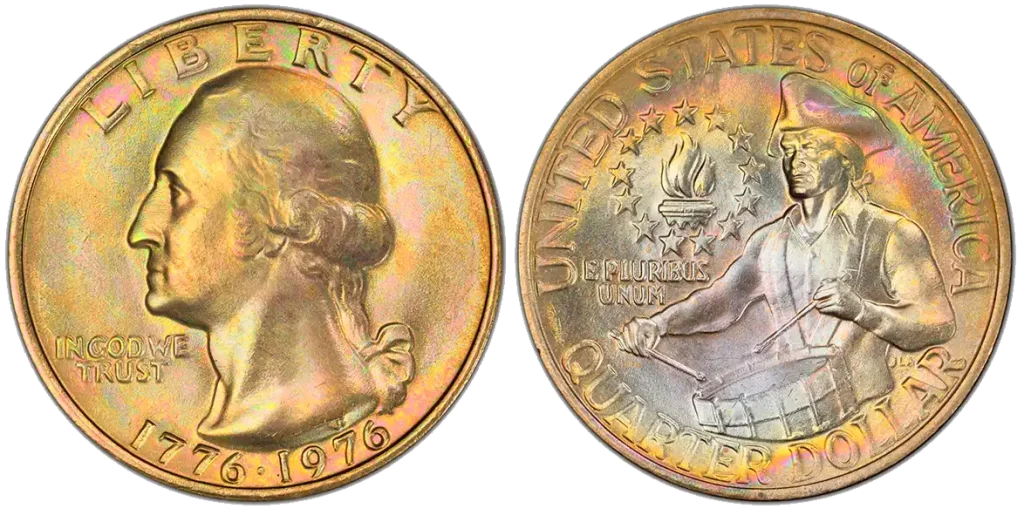
Are any Bicentennial quarters valuable? Yes, of course, but it’s important to realize that not every 1976 coin is worth a lot. The price and value of a coin is not easy to determine, as there are many nuances to consider. Today we will just talk about it:
- What makes a coin valuable, expensive and desirable among numismatists?
- What Bicentennial quarters are valuable?
- What special things do you need to keep in mind so you don’t overlook a potentially valuable 26-cent example?
Welcome to the world where a quarter can be worth more than an ounce of gold and let us start here.
Ultra-Rare Key Dates & Errors
First, it would be good to determine the answer to the question of what makes Bicentennial quarters valuable? Well, the main factor in the value of 25-cent commemorative pieces is their rarity and uniqueness. Coins that differ from standard specimens in design, year marks or technical features attract the attention of collectors and can grow in value over time.
By the way, sometimes even one small mistake at the mint can turn out to be a great fortune. And among all specimens there are some pieces that are rightfully considered to be some of the most expensive and valuable rare Bicentennial quarters on the market. Below you will find the top three valuable pieces.
1. 1976 No-S Proof Quarter (Missing Mint Mark)
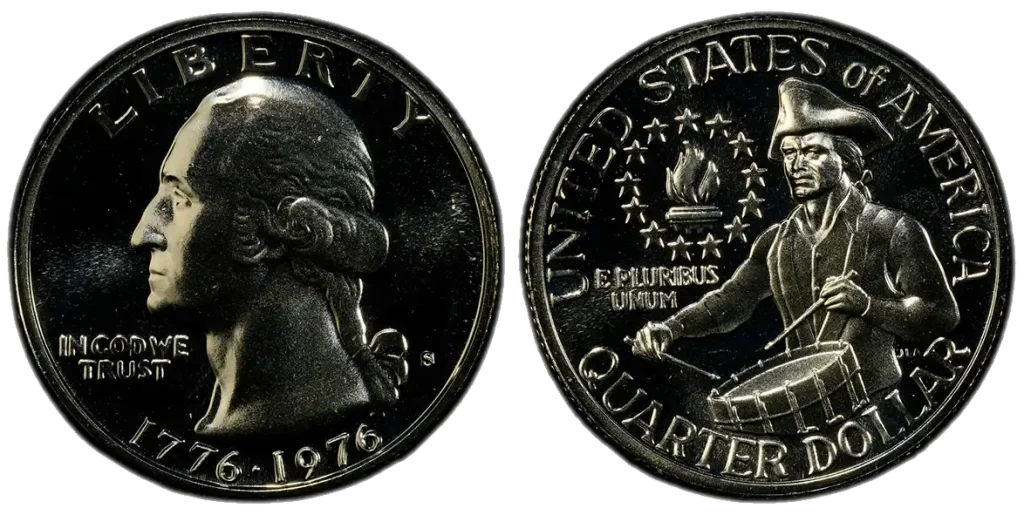
- Value: $15,000–$20,000+
- Key feature: Proof coin missing the “S” mint mark
- Known examples: Only 3–5 confirmed by PCGS and NGC
- Last auction price: $19,200 (Heritage Auctions, 2023)
This rare error occurred at the San Francisco Mint, where all proof coins are required to receive the “S” mintmark. However, several pieces were minted without it. The reason could be a test minting with an unsuitable stamp or an accidental replacement of the blank.
The coin looks like an ordinary proof, but the absence of the “S” makes it exceptional. Such specimens were not included in official sets and were not intended for circulation. No more than five pieces are known, each with a certification. One of them was sold at a Heritage auction for $19,200 – a rare case where a technical error makes the coin one of the most valuable 1976 Bicentennial quarters.
2. 1976-D Doubled Die Obverse (FS-101)
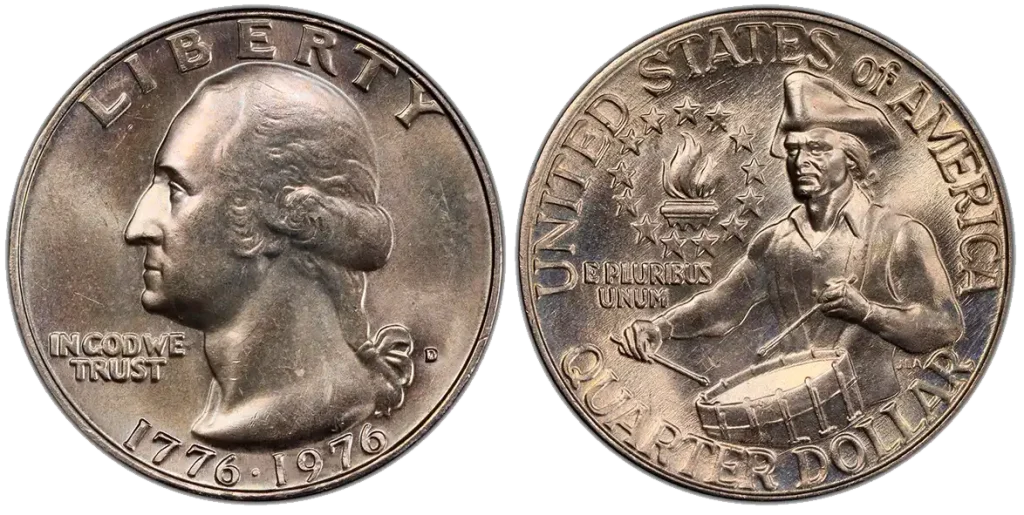
- Value: $500–$5,000
- Sign to look for identification: Doubling of the inscription “IN GOD WE TRUST” and the date
- Graded Examples: In MS-65 condition, the price is as high as $3,000+
Double die strike errors are a classic of the genre among coin errors. And this 1976-D error piece is one of the most interesting variants and can serve as a prime example for people looking for answers to the question, “why are Bicentennial quarters valuable?”
This error variant came about because of a shift in the stamp during die making. The error resulted in a clear doubling of elements on the obverse: the doubling is especially noticeable on the inscription “IN GOD WE TRUST” and the double date “1776-1976”.
It is not difficult to detect the defect (but sometimes you may need a magnifying glass or numismatic microscope) – the lines of letters and numbers can be as if “blurred” or duplicated.
3. 1976 Silver Quarter Struck on Wrong Planchet
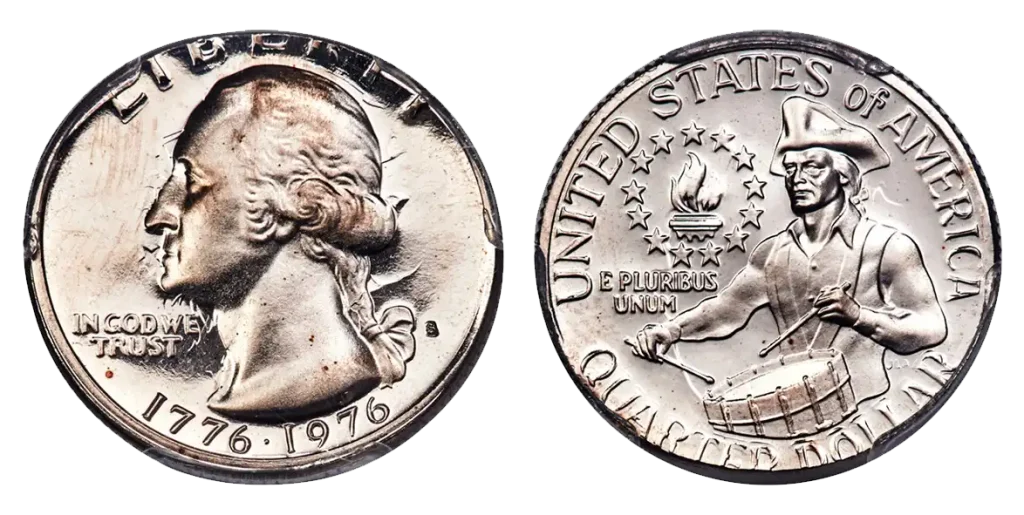
- Value: $2,500–$10,000
- Key feature: Blank from another coin (dime, nickel)
- Sign to look for identification: Weights below normal are 2.27 g (dime) or 5.0 g (nickel)
Sometimes in the production of coins in the stamp get blanks from other denominations – so there were silver quarters minted on blanks from dimes or nickels. The main characteristic is a weight mismatch with the standard 5.67 g and a reduced diameter.
The coin may sometimes look normal but the scales will immediately point out the anomaly. Such cases are extremely rare, especially if it is a silver version. With a confirmed examination (e.g. from NGC or PCGS), the price can even exceed $10,000.
Premium Silver Varieties
In honor of the 200th anniversary of American independence, the Mint issued not only regular coins for mass use, but also special collector versions in 40% silver.
These pieces were minted exclusively in San Francisco and intended for numismatists as part of the Silver Uncirculated and Silver Proof Sets. Due to their limited mintage and high quality of workmanship, these quarters are valued above their copper-nickel counterparts.
4. 1976-S Silver Proof (Deep Cameo)
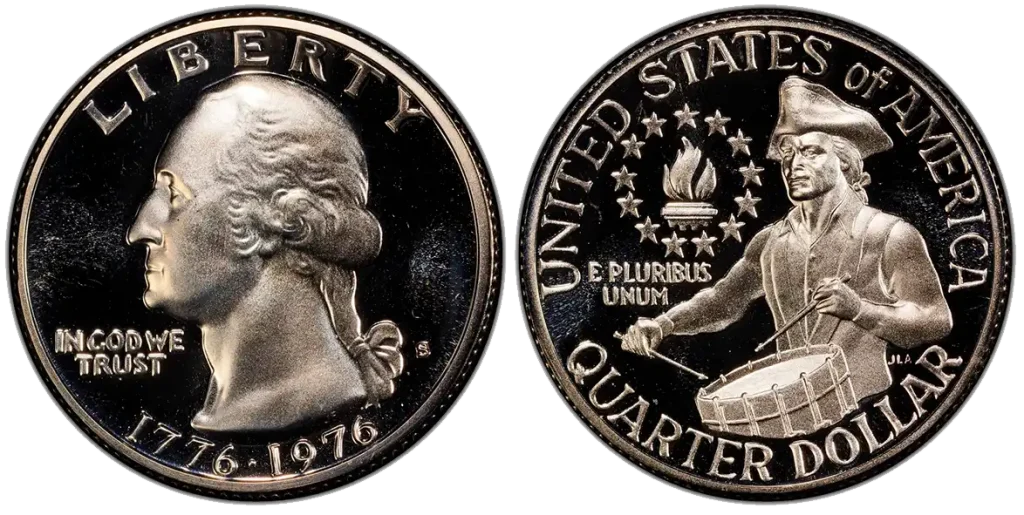
- Value: $25–$150
- Key feature: Mirror background and matte image
- PR-70 specimens value: $300–$500
This coin was minted for collector sets at the San Francisco Mint in 40% silver. The distinctive feature is the deep contrast between the shiny mirror field and the matte details. This effect is called Deep Cameo (DCAM).
High grades, especially PR-69 and PR-70, are given only to perfectly polished specimens without the slightest defects. Coins in PR-70 are rare, and in this condition the price is considerably higher – up to $500.
5. 1976-S Silver Uncirculated (MS-68+)
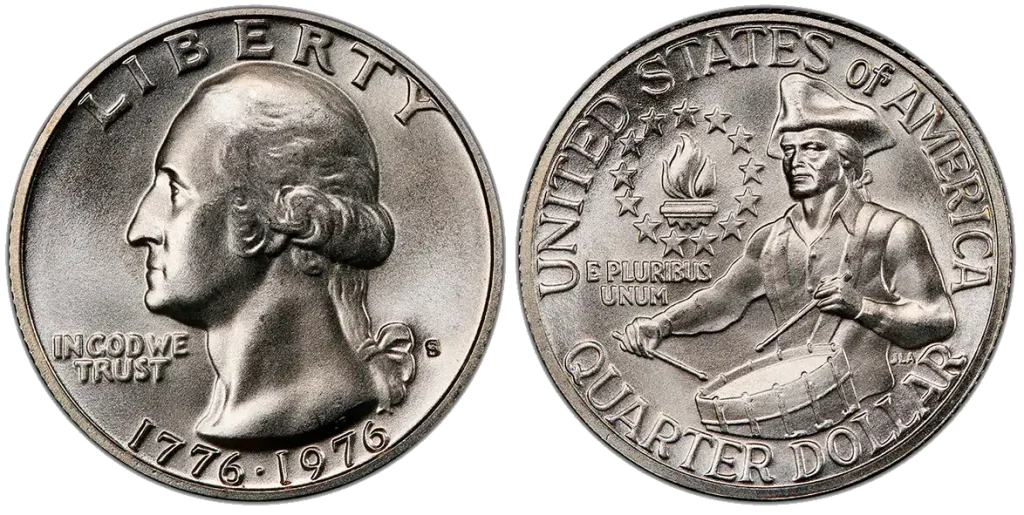
- Value: $50–$400
- Key feature: Shimmering white shine, no handling or wear signs
- Top population: Only 12 instances with an MS-68+ grade at PCGS
Unlike proof coins, this version was produced without mirror polishing, but still retained an exceptionally high quality of minting. Such quarters were part of silver uncirculated sets and were not put into circulation.
They are easily recognized by their rich white hue and almost complete absence of contact marks. Specimens with MS-68 grade and higher are considered especially valuable. According to PCGS, only 12 such coins are known, which makes them extremely rare in this condition at the time of publication. Even non-ideal MS-66 or MS-67 versions may be of interest to collectors, but collectors are willing to pay many times more for “top” specimens.
Valuable Error Coins
Minting errors are a separate and very popular category in numismatics. Such coins appear as a result of technical failures and despite the fact that quality control in 1976 was quite strict, a certain number of defective quarters still leaked into the market. Especially valuable are rare and spectacular errors that clearly demonstrate failure in the minting process:
1976 50% Off-Center Strike
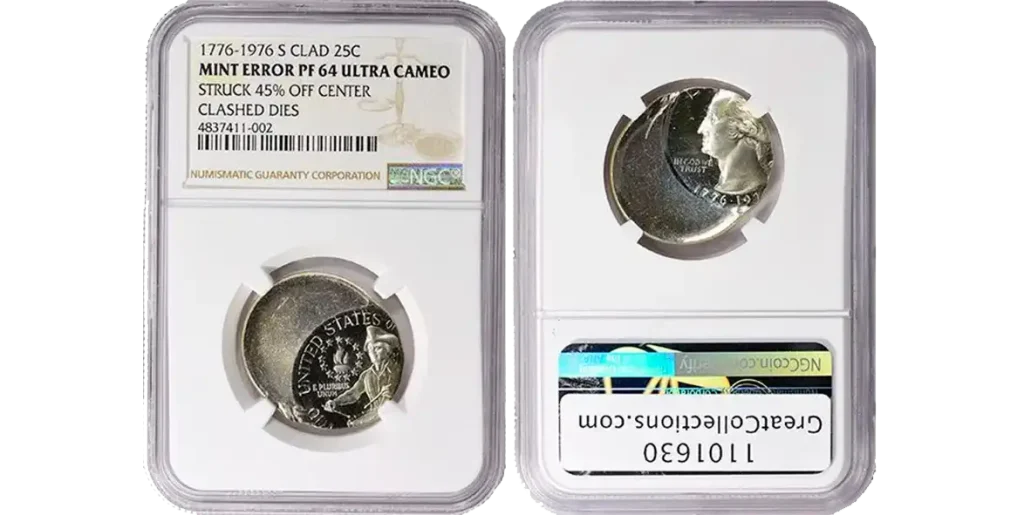
This error occurs when the coin blank enters the press displaced by about 50%. As a result, one half of the coin displays only part of the design, while the other half is completely blank. Such specimens look spectacular and are highly valued among collectors.
Especially important is the safety of the date: if it is fully visible on the printed part – it significantly increases the value. The price of this erroneous variant can reach $750 -$2,500.
1976 Triple-Struck Quarter
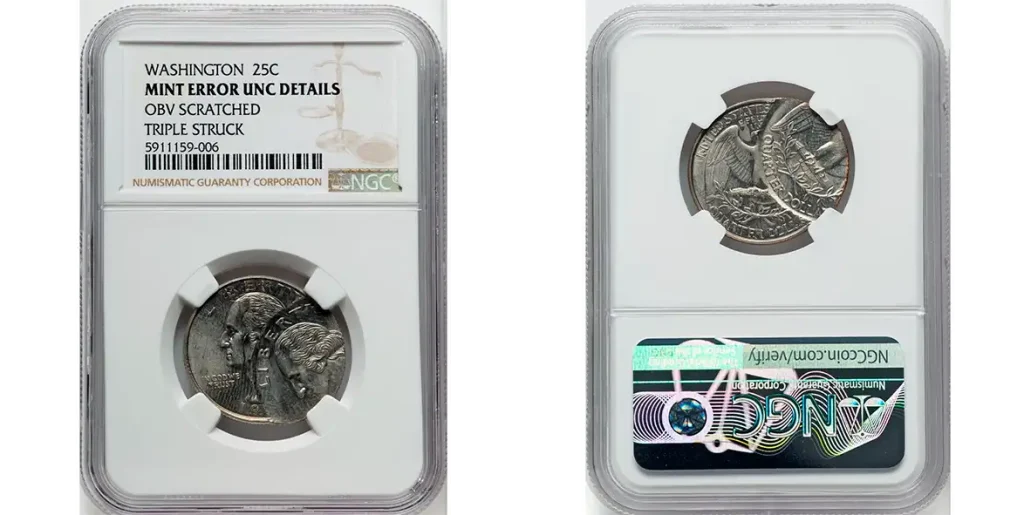
A rare and spectacular error in which the coin was struck three times by the press, each time with a shift. The coin shows overlapping images – usually the outline of Washington’s head and dates – duplicated by the shifts.
Such errors are very rare, especially in commemorative series. To date, fewer than ten copies with such a defect are known. The price of such coins can reach $3,000-$8,000, especially if the images are clear and the coin has no other damage.
1976 Brockage Strike
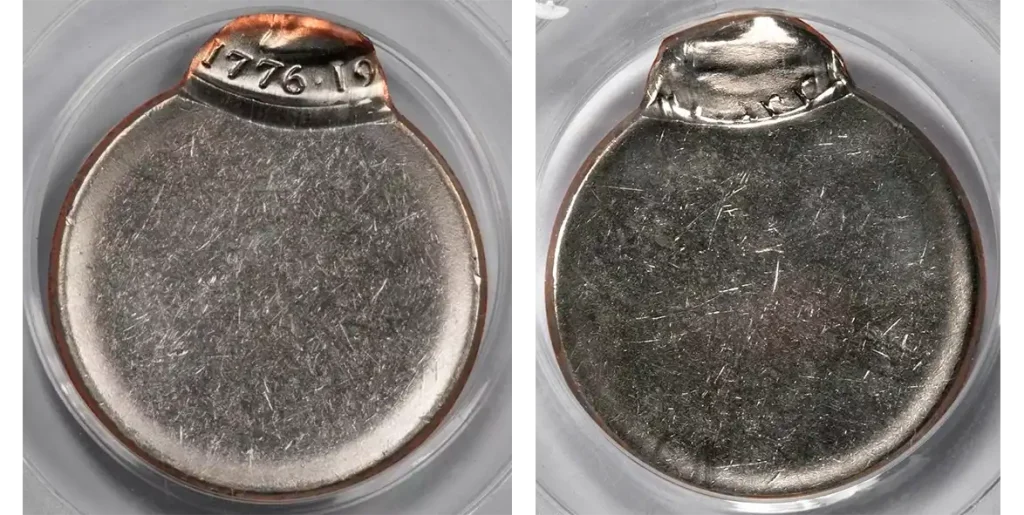
This defect occurs when an already minted coin gets stuck on the lower or upper stamp, and the next blank is imprinted with the relief of another coin instead of the metal die. The result is a mirror imprint of one coin’s side instead of the usual design.
For anniversary quarters such errors are extremely rare. Especially valuable are full brockage-specimens – when the entire relief on one side of the coin is reproduced mirror-image. The price depends on the degree of preservation and completeness of the image, reaching up to $1,500-$5,000 for a piece in excellent condition.
How to Identify Valuable Bicentennial Quarters
How to say which Bicentennial quarters are valuable? Not all 1976 Bicentennial coins can be profitable, but there are some real “dark horses” among them. If you don’t want to miss some valuable finds, it is important to know what to look out for. Below are a few simple steps to quickly distinguish rare specimens from ordinary ones.
- Check the Mint Mark
- Without a mint mark, these coins are from Philadelphia – the most common specimens.
- The mint mark “D” is from Denver. Pay attention to possible double strikes (DDO) – they can be valuable.
- The mint mark “S” is from San Francisco. Almost always rarer and more valuable, especially if it is silver or proof version.
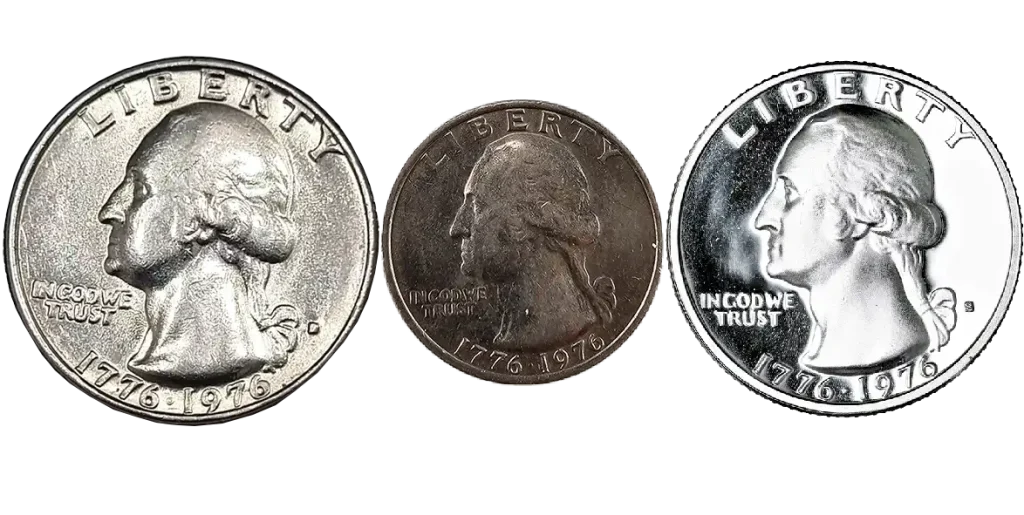
- Pay Attention to the Coins Weight
Weight can tell you more than it seems. Here it is not only a physical parameter, but also a key to determining the metal.
- Silver coins weigh about 5.75 g, are not magnetic and make a characteristic “clinking” sound when dropped.
- Common (clad) ones are about 5.67 g, often have a copper edge and may react weakly to a magnet.
A difference of 0.08 grams seems insignificant, but with accurate scales it can be decisive.
- Look for Minting Errors
Errors are real numismatic luck, because the value of such specimens can be many times higher than the standard one. You need to arm yourself with a 10x loupe or a digital magnifier – without it, microscopic deviations cannot be noticed.
What to Look for?
- Doubled die – especially common on coins marked “D”. First of all, check inscriptions and dates – that is where doubling is visible most often
- Off-center strike – part of the image has moved to the edge. The greater the offset, the more valuable the coin.
- Absence of mint mark – for proof coins this is a serious rarity. Especially if we are talking about 1976-S. Such defects are not always conspicuous, but they can turn an ordinary coin into an object of auction interest.
- Other rare varieties can also be found.
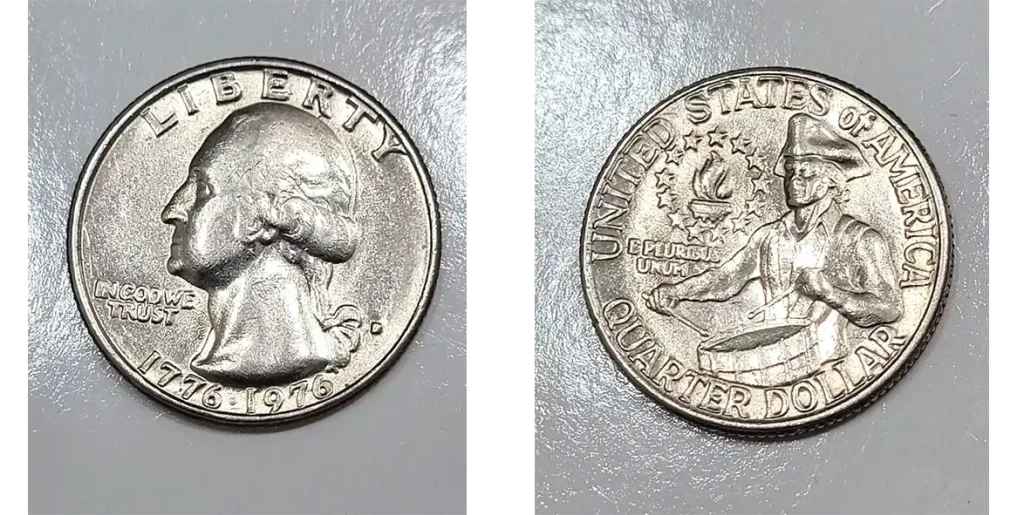
- Remember that Grading Matters
The condition of a coin directly affects its value. Even rare pieces lose value if they are worn. Condition is assessed on the Sheldon scale (1-70):
| Grade/ Condition | The Sheldon Score | What It Means |
| Circulated | 1–59 | There are signs of wear and tears, scuffs. The cost is noticeably lower. |
| Uncirculated | MS-60–MS-70 | No wear, with original luster. MS-66+ are more expensive. |
| Proof | PR-60–PR-70 | Mirror surface. Top grades (PR-69, PR-70) are rare. |
The higher the grade, the higher the value. If the coin looks like a new one, it is better to show it to a specialist.
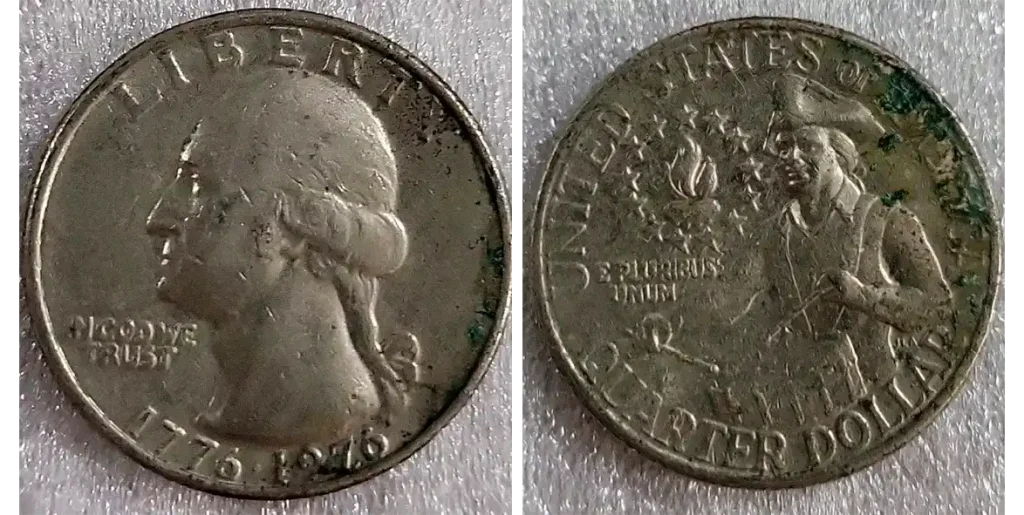
FAQ
How can I tell if my Bicentennial quarter is silver?
The most reliable way is to check the weight. Silver specimens are heavier and are not magnetic. In addition, they have a “dull” sound when dropped on a surface and a light-colored edge without a copper layer.
What makes the 1976 No-S proof quarter so valuable?
This is an exceptionally rare proof coin, issued by mistake without a mint mark. Such cases are almost never repeated, and these pieces are worth thousands of dollars.
Are Bicentennial quarters still in circulation?
Yes, they can still be found in circulation, although less and less often. Many are already in collections, especially those in good condition.
How much is a 1976-S silver proof quarter worth?
The price can vary depending on preservation – from $25 to $150. In perfect condition (PR-70) the cost can reach $500.
What’s the most common valuable Bicentennial quarter?
Among the common ones are the 1976-S silver proof as well as the double struck DDO coins, especially on Denver coins. Focus on these if you are looking for a valuable, but not the most expensive option.
Should I clean my old Bicentennial quarter?
Absolutely not! Even gentle cleaning can damage the surface and collapse the value of the coin. Collectors appreciate the original condition, including the natural patina.
Well, finally you should remember that not all 1976 Bicentennial 25 cent-coins are worth a lot of money, but a careful attitude and a little knowledge can help you find really valuable specimens. Silver versions, rare minting errors and coins in excellent condition are the first things to look for.
If you want to simplify your search and quickly determine how interesting your find is, be it valuable rare dimes bicentennial quarters or any other coin, try the Coin ID Scanner app. Due to the app users can easily recognize coins, shows their rarity, market value, historical information, and allows you to store your collection in one place. So, install the app and explore the numismatic world with confidence.